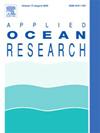Influence of the hydraulic power take-off system on the dynamic response and power output of a wind-wave hybrid system
IF 4.3
2区 工程技术
Q1 ENGINEERING, OCEAN
引用次数: 0
Abstract
The power take-off (PTO) system plays a crucial role in the wind-wave hybrid system that directly affects the efficiency of wave energy conversion and the relative motion between buoys and the platform. The hydraulic PTO system, a commonly used type of wave energy conversion, has demonstrated practicality and reliability in practical projects. Effects of the hydraulic PTO system on the dynamic response and power output of the hybrid system are unclear due to the limitations of current simulation tools. Therefore, based on potential flow theory, the Laplace equation, blade element momentum theory, and others, this paper proposes an aero-hydro-servo-hydraulic-mooring fully coupled simulation method. The effect of hydraulic parameters (i.e., the piston area, motor displacement, orifice area, equivalent damping, initial volume, and pre-charge pressure) on the hybrid system is studied. The results show that the hydraulic parameters significantly influence the natural periods of heave and pitch of the platform, with variation amplitudes of 14.2 % and 12.27 %, respectively. The phase and amplitude of the PTO force significantly influence the surge, heave, and motion responses of the platform. For deterministic sea states, the same set of hydraulic parameters cannot simultaneously maximize the power generation of the WEC micro array and minimize the pitch motion response of the platform. Hydraulic parameters have negligible effect on the average values of the power generation and rotor torque of the wind turbine, but affect the amplitudes. Furthermore, the established framework can effectively simulate the working process of the hydraulic PTO system in a wind-wave hybrid system, which can provide essential pre-research for the actual hydraulic control to improve the wave energy conversion efficiency and hybrid system stability.
求助全文
约1分钟内获得全文
求助全文
来源期刊

Applied Ocean Research
地学-工程:大洋
CiteScore
8.70
自引率
7.00%
发文量
316
审稿时长
59 days
期刊介绍:
The aim of Applied Ocean Research is to encourage the submission of papers that advance the state of knowledge in a range of topics relevant to ocean engineering.
 求助内容:
求助内容: 应助结果提醒方式:
应助结果提醒方式:


